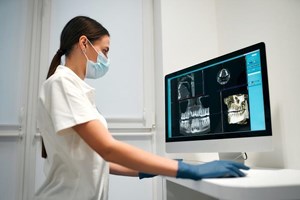Dental X-rays may increase the risk of thyroid cancer and meningioma
Published: 29/10/2019
Repeated exposure to dental X-rays may increase the risk of thyroid cancer and tumours in tissue covering the brain and spinal cord, according to new research.
About 3,500 new cases of thyroid cancer and 1,850 ‘meningiomas’ (tumours which are mostly benign and grow slowly), are diagnosed each year in the UK and researchers have discovered an increase in both diseases in many countries in the past 30 years.
Professor Anjum Memon, Chair in Epidemiology and Public Health Medicine at Brighton and Sussex Medical School, said much of the increase in thyroid cancers is “probably due to increased surveillance, screening and over-diagnosis (i.e. detection of a cancer that would not ultimately cause symptoms), but we believe other causes need investigation.”
He said the thyroid gland is situated in the neck and the meninges cover the brain and spinal cord: “These organs will be exposed to radiation from dental X-rays. Both organs are highly radiosensitive, particularly in childhood and adolescence. Dental radiography, a source of low-dose diagnostic radiation, is often overlooked as a potential hazard to these organs.” He said more research was needed to further test the hypothesis.”
The researchers conducted a systematic review and meta-analysis, which summarised the findings from all the previously published studies on dental X-rays exposure and the risk of thyroid cancer, meningioma and other cancers of the head and neck region.
Professor Memon said the results of their research “should be treated with caution because these studies did not include individual organ doses and ages at exposure, and are subject to recall bias and other limitations.” The researchers said that their synthesis provides good evidence to warrant more research based on dental X-rays records and patient follow-up to test the hypothesis further.
Professor Memon said: “Little is known about the impact and magnitude of risk associated with dental X-rays, which have been the fastest growing source of human exposure to low-dose ionizing radiation during the past three decades – with many patients being exposed to dental X-rays on multiple occasions over many years. Given this high life-time prevalence and frequency of exposure, even a small associated increase in cancer risk would be of considerable public health importance.”
He said: “The clinical and public health implications of these findings are relevant in light of the increasing incidence of thyroid cancer and meningioma in many countries. Our study highlights the concern that like chest or other upper body X-rays, dental X-rays should be prescribed when the patient has a specific clinical need and not as a standard part of evaluation for new patients, for routine check-up, or for periodic screening for dental caries/decay in children/adolescents.”
“Current UK, European and USA guidelines stress the need for thyroid shielding during dental radiography.”
He added: “The findings also stress the need for maintaining comprehensive long-term dental X-rays records, which could follow the patient when they register with a new dentist – thus avoiding the need for unnecessary X-rays.”
“The notion that low-dose radiation exposure through dental radiography is completely without risk needs to be investigated further. Although the individual risk, with modern technology and equipment is likely to be very low, the proportion of the population exposed is high.”
“Considering that about one-third of the general population in developed countries is routinely exposed to one or more dental X-rays per year, these findings manifest the need to reduce diagnostic radiation exposure as much as possible.”
The research team of Professor Anjum Memon with Dr Imogen Rogers, Dr Priya Paudyal and Dr Josefin Sundin, whose findings are published in the journal Thyroid, 2019, called for further studies based on dental X-rays records and patient follow-up.
The study is published in the journal Thyroid (published by the American Thyroid Association) https://www.liebertpub.com/doi/10.1089/thy.2019.0105
Author: Julie Bissett













